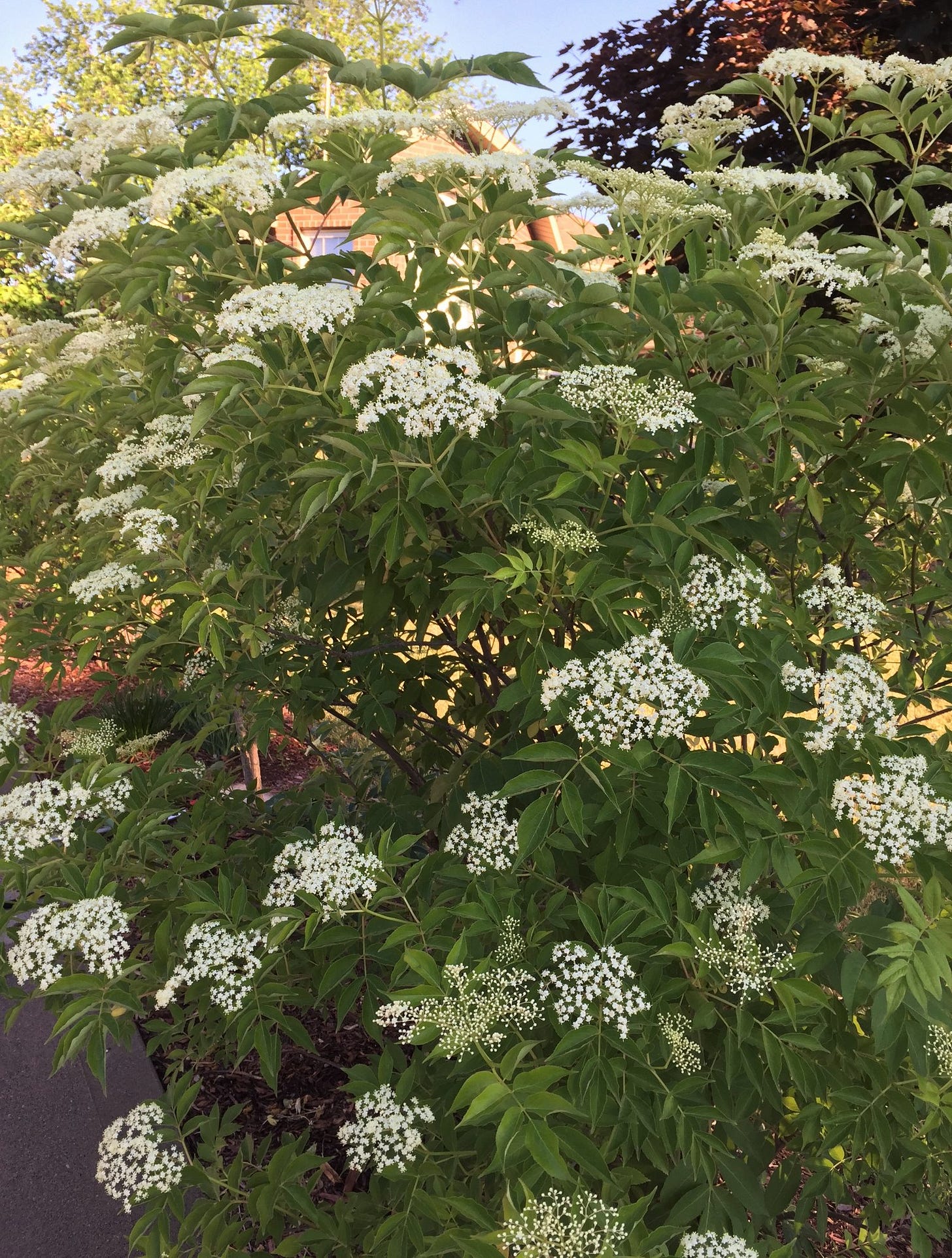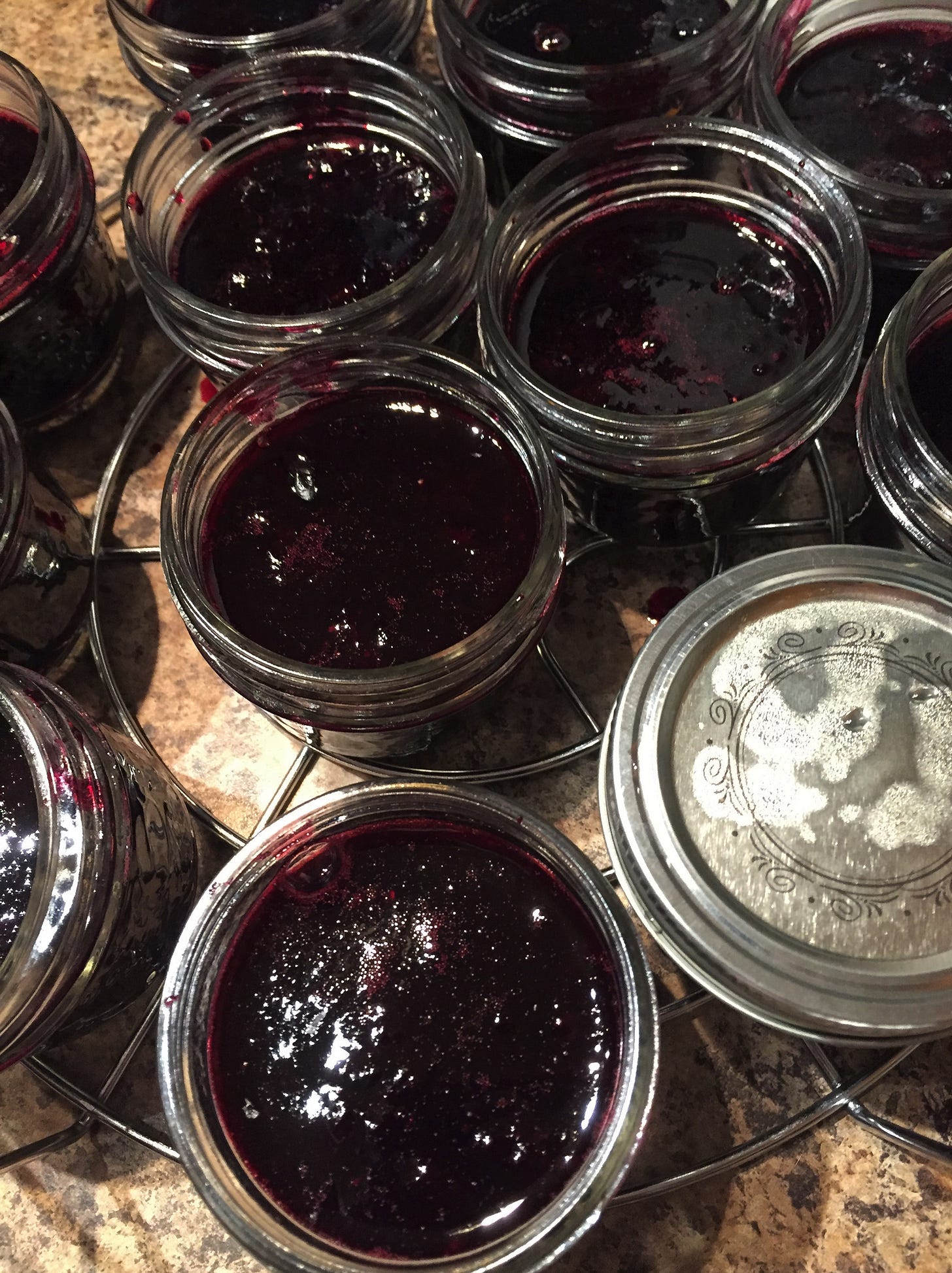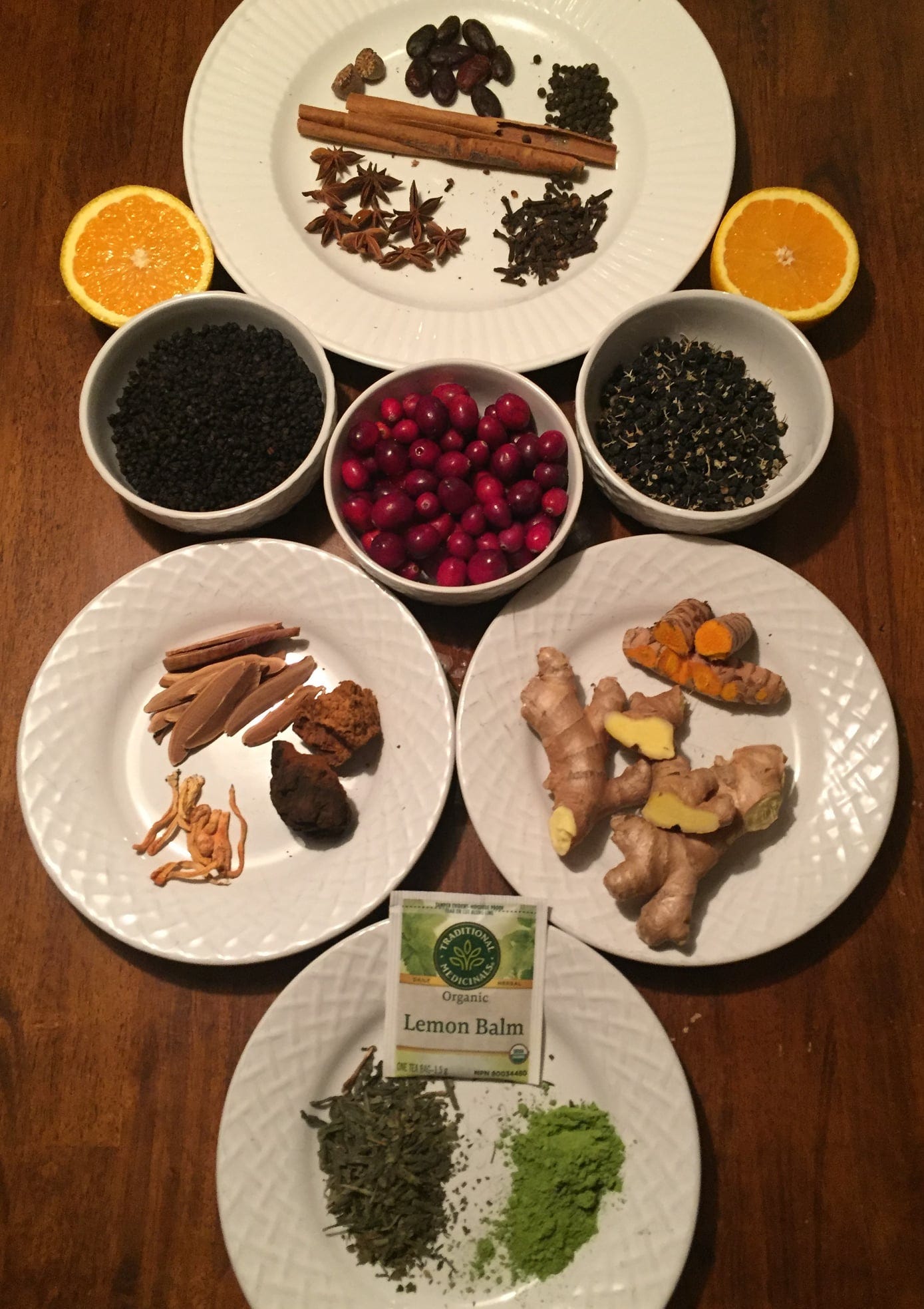Endless Elderberries and a sneak peak of our Exponential Immunity Elderberry Syrup recipe
(an exploration of the regenerative community functions, culinary creative potential and medicinal benefits that are offered by elderberries)
"In our society growing food ourselves has become the most radical of acts. It is truly the only effective protest, one that can — and will- overturn the corporate powers that be. By the process of directly working in harmony with nature, we do the one thing most essential to change the world — we change ourselves."
— Jules Dervaes
We love growing our own elderberries in our front yard as they serve both the functions of aesthetic appeal, soil stabilization, providing for native pollinators and providing us with blossoms and berries for making a wide array of delicious and powerfully medicinal preserves.
This plant was used for millennia by Native Americans and First Nation peoples of what is now called Canada and the United States for many medicinal purposes (and for good reason). The purple-black fruit is attractive to birds that spread the seeds. The fruit can be used to make delicious jelly, jam, wine, medicinal syrup (and many other things).
Over the past couple years I have experimented with various ways to preserve our elderberry harvests and have come to find that one of my favorite ways to preserve the antioxidant rich essence of the berries is via separating the juice/pulp from the raw ripe berries so that I can also save seed to share in our local community and abroad.
In a recent substack blog post I explored one way of perceiving the untapped exponential value that is unlocked when we ‘invest in the Earth’ (via growing heirloom crops, save seed and sharing the resulting abundance) and then when picking some ripe elderberries from our garden the other day I figured why does kale get to have all the fun!? I can unlock the same type of exponential abundance with elderberries too!
The typical method for preserving elderberries involves cooking them down to get all the good antioxidants out and make syrup/jelly. Don’t get me wrong, that method is great (and I still do that somtimes) but I figure why not also set some ripe berries aside to take an extra step so that the healing and life enriching gifts of the Elder plant can spread outwardly into the broader community via saving/sharing seed. Thus, one of my main missions each time elderberry harvest season comes along is stacking functions by saving seed while simultaneously making elderberry juice and pulp for preserving.
Some say that growing things like elderberries from cuttings is preferable due to the fact that the seed will not grow 'true to type'. Though in a time when erratic weather patterns are putting unprecedented pressure on our tried and tested favorite asexually reproduced crops and the homogenization of food runs rampant, perhaps allowing nature to add some diversity and regional adaptation is actually a benefit and not a detriment (despite the fact we may not get uniform ripening of berries or symmetrical bush sizes). Also, seeds are a lot more easy to transport and have a longer shelf life than cuttings, so despite them being hard to germinate, saving/sharing seeds really appeals to me.
Don't get me wrong, I take cuttings from our best producing and most resilient elderberry, fig, service berry, blueberry and goji berry plants annually in the interest of maintaining those favorable attributes and being able to produce fruit/berries faster than growing from seed, but I also see value in genetic diversity and allowing nature to do it's thing.
It is in the interest of that that we save elderberry seeds anually. What I do is first separate the ripe berries from the stems by hand.
I pop the berries off of the stems into a fine mesh strainer and then mushed them up over a bowl to collect the nutrient/antioxidant rich juice.

I then squeezed the mushed up berries in my fist to get as much juice as possible before adding the squished berries/pulp/seeds to a mason jar with some water to begin fermenting.
The fermentation served two purposes. One, CO-2 production initiated by the wild yeasts made the majority of the berry skins/pulp float to the top of the liquid (leaving the heavier more viable seeds at the bottom of the jar). And two, the fermentation hopefully acted as a mild solvent, simulating the action of the stomach acid of a bird that would typically be involved in increase the germination rates of these seeds in the wild.


Ideally I would have loved to put the crushed berries/pulp into a batch of kombucha (as this would have pulled the healthful compounds out of the skins/pulp by the action of not only yeast but also the beneficial bacteria present in the SCOBY). Not only would it allow the seeds to be separated via the CO-2 production of fermenting microbes, it would also result in a nutrient dense medicinal beverage (and perhaps serve as a more effective simulation of bird stomach acid via the action of the LAB in the SCOBY). So any of you Kombucha brewers out there who also grow elderberries, please let me know if you ever try this and have good results!
In the interest of wanting to embrace the spirit of gift economics and help unlock the exponential value contained within a single seed in our local community I recently made some Elderberry Jam with some of our homegrown blueberries and some locally grown organic strawberries with the intent of giving some away along with Elderberry seeds saved from our berries.
The jam goes great with breakfast items or over ice cream but I often just eat it by the spoonful because it is so delicious and nutritious

Other ways I like to preserve our elderberry harvest is via combining with an array of other medicine plants/fungi and making powerful medicinal syrups like this one:

Other ways we like to enjoy Elderberry harvests are in Kombucha, Wine, Mead and added to lacto-fermented veggie preserves.
Now for some info on the many medicinal benefits offered by Elderberries.
Health benefits of the elder plant include naturally improving sinus issues, nerve pain, inflammation, chronic fatigue, allergies, constipation and even cancer. When used within the first 48 hours of onset of symptoms, preserves and extracts made form the berries help relieve and shorten the duration of cold and flu symptoms significantly.
Both Sambucus canadensis (American black elderberry, Canada elderberry, or common elderberry) and Sambucus cerulea (blue elderberry and blue elder) have edible and nutritious fruit that can be gathered.
Medicinal use of Elderberry:
Elder has a very long history of household use as a medicinal herb and is also much used by herbalists. The plant has been called "the medicine chest of country people". The flowers are the main part used in modern herbalism, though all parts of the plant have been used at times. Stimulant. The fresh flowers are used in the distillation of "Elder Flower Water". The flowers can be preserved with salt to make them available for distillation later in the season. The water is mildly astringent and a gentle stimulant. It is mainly used as a vehicle for eye and skin lotions. The dried flowers are diaphoretic, diuretic, expectorant, galactogogue and pectoral. An infusion is very effective in the treatment of chest complaints and is also used to bathe inflamed eyes. The infusion is also a very good spring tonic and blood cleanser. Externally, the flowers are used in poultices to ease pain and abate inflammation. Used as an ointment, it treats chilblains, burns, wounds, scalds etc. The fruit is depurative, weakly diaphoretic and gently laxative. A tea made from the dried berries is said to be a good remedy for colic and diarrhoea. The fruit is widely used for making wines, preserves etc., and these are said to retain the medicinal properties of the fruit.
Edible parts of Elderberry:
Fruit - cooked. (some eat raw but moderation should be practiced due to cyanogenic glycoside content, see below for more info) The flavour of the raw fruit is not acceptable to many tastes, though when cooked it makes delicious jams, preserves, pies and so forth. It can be used fresh or dried, the dried fruit being less bitter. The fruit is used to add flavour and colour to preserves, jams, pies, sauces, chutneys etc, it is also often used to make wine. The fruit is about 8mm in diameter and is borne in large clusters
Flowers - raw or cooked. They can also be dried for later use. The flowers are crisp and somewhat juicy, they have an aromatic smell and flavour and are delicious raw as a refreshing snack on a summers day, though look out for the insects. The flowers are used to add a muscatel flavour to stewed fruits, jellies and jams (especially gooseberry jam). They are often used to make a sparkling wine. A sweet tea is made from the dried flowers. Harvest and dry berries for later use if you have access to an abundant patch.
Are elderberries safe?
Elderberries (leaves, stems, and seeds) contain cyanogenic glycosides which can be toxic in extreme quantities but in small amounts can be expelled from the body, also this compound is rendered inert and evaporated through heat. You’ve probably encountered other plants that also contain these cyanide compounds like apple seeds, grape seeds, bitter almonds, apricot and peach pits, for instance. It’s the same ingredient as Amygdalin, the cyanide compound found in bitter almonds. When ingested in small amounts these compounds are naturally helpful in initiating apoptosis (safe programmed cell death of cancer cells) in certain types of cancer cells and in small amounts this compound is excreted by the liver and kidneys and pose no concern for healthy people.
Folk remedies often use the bark and leaves of elderberries therapeutically, in spite of the cyanogenic glycosides, which can cause nausea and vomiting when consumed in large amounts. The cyanide compounds are more concentrated in stems and leaves than in the flowers or the berries. When using the flowers and berries in herbal remedies the stems should be removed so that the concentration of cyanogenic glycosides is less.
Certain varieties and amounts of raw elderberries have been shown to cause nausea, vomitting, and abdominal cramps in some people. Cooking avoids this for those with sensitive stomachs.
I love how Elderberries can serve so many functions in the garden and the community (such as how the strong lateral root system of the plant helps to stabilize soil on embankments prone to erosion, the blossoms can provide nectar to native pollinators and can also be used to make a bubbly wild fermented nutritious beverage that is reminiscent of champagne, the suckers that emerge from the mulch at the base of each plant in the spring can be separated from the roots and propagated to share with friends and neighbors, the berries provide food for birds and nutrient rich food and powerful medicine for humans while enabling one to save seeds at the same time to share them far and wide, sending out the regenerative ripple effects of endless elderberries into larger circles of community in the world).
I hope this inspires you to try growing some of your own (and/or foraging for some in the wild if they grow where you live) and saving seed to share locally as well.
When we choose to give back to the living planet that sustains us and share the resulting abundance, the rewards increase exponentially and continue to give back year after year. These are the intrinsic characteristics of a Gift Economy. We can nurture and become part of the web of that cycle of gifts and abundance through investing in the Earth with our hands and our hearts and then sharing the resulting abundance freely.
I will be including tips for companion planting, seed saving and additional info on other medicinal plants in my upcoming gardening/recipe book.
You can learn more about my book and pre-order a copy through this link: recipesforreciprocity.com














Excellent article. I have recently, in the last year and a half, moved to a rural area, with a big enough yard for several trees and bushes. The soil sux, but that's another story, it can be fixed. I have planted a couple of apple trees, and am raising some mulberry trees from seed. Elderberry is on my list also. I believe in planting functional trees and plants, organisms that will provide me with something I need, like food, in return for my work of amending the soil and planting and caring for it. I like to eat fruits, but can't really afford fresh fruit anymore, on my fixed income. I try to collect seeds everywhere I go, when I see something growing I want. I do better with fruits by planting the complete fruit in the pot, like a whole mulberry will sprout about 20 little trees, then as they grow cull the smaller ones, until they are big enough to put in the ground. With Apple trees, I cheated an bought a couple of trees, because I needed specific varieties top grow in my zone, and for pollinating each other. I do not like to eat vegetables, and I am disabled an unable to really take care of a vegetable garden. I can get on my knees and dig a hole to plant a small tree in with a short army shovel, and can manage to drag bags of soil amendments out to the hole, and plant the tree, but I can't walk well enough to make it between rows of plants without stepping on them. And, best of all, eating something you grew on your property, standing back and looking at the trees as they grow, and knowing that you got nature started by your own work and sweat to make food grow out of the dirt.
love. it.